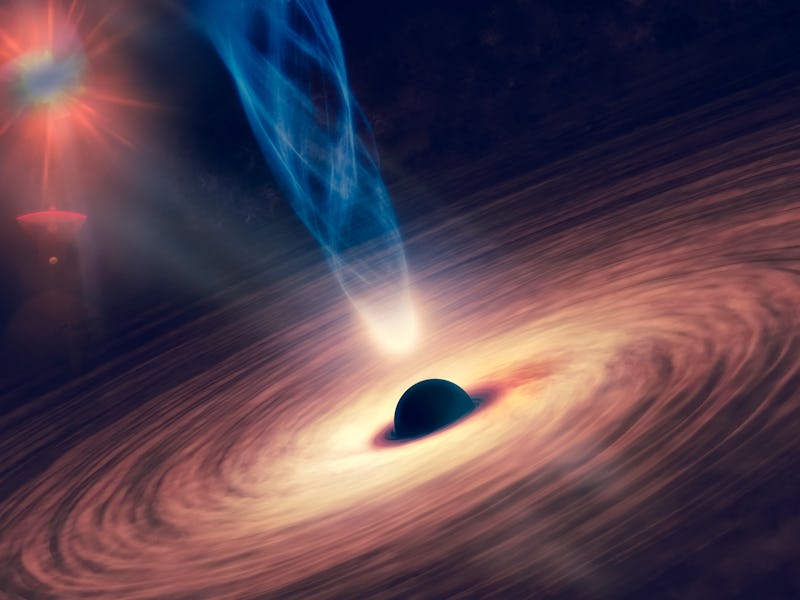The discovery of an epic black hole is defying astronomical theory
This black hole shouldn't exist, but scientists found it anyway.

A theory-defying discovery has shocked astrophysicists, and may lead to a new whole new understanding of black holes.
Astrophysicists estimate that our Milky Way Galaxy alone is home to 100 million stellar black holes, and scientists have estimated through theoretical models that these black holes are no bigger than 20 times the mass of our sun.
But the Chinese Academy of Sciences has recently found a black hole that appears to be a whopping 70 times the mass of our sun. And it’s only 15 thousand light-years from Earth. Scientists say this discovery now throws into question long-standing theories about how black holes develop.
The study describing this discovery was published this week in the journal Nature, and details the unusual method the authors used to discover this black hole, referred to as LB-1, as well as possible origin stories for the behemoth.
Traditionally, black holes are identified by observing X-ray emissions created after a black hole has gobbled up its companion star (kind of like an after-dinner belch). However, of all of the black holes predicted to exist in our galaxy and beyond, the majority are living more peacefully with their companion stars and thus don’t emit these tell-tale X-rays to help astrophysicists find them. As the study’s authors found, such was the case for LB-1.
An artist's interpretation of the LB-1 black hole and companion star.
Radical velocity
Therefore, in order to identify this system, the authors instead used a method that had been long theorized but had yet to actually identify a black hole: radial velocity. Much like finding a needle in a haystack, this approach required the authors to scan the sky with China’s Large Sky Area Multi-Object Fiber Spectroscopic Telescope (LAMOST) in search of stars that appeared to be orbiting large, invisible objects, aka potential black holes.
While the odds were low that in a sky full of stars the authors would find one star exhibiting such behavior, the authors were excited and shocked when they not only discovered a star orbiting such an invisible object every 79 days, but that the system turned out to be much stranger than they’d anticipated.
The team’s leader, Professor Jifeng Liu of the National Astronomical Observatory of China of the Chinese Academy of Sciences (NAOC), says that this unexpected discovery will now challenge theorists to explain how such a massive black hole could come to be.
"Black holes of such mass should not even exist in our galaxy
“Black holes of such mass should not even exist in our galaxy, according to most of the current models of stellar evolution,” Liu says. “We thought that very massive stars with the chemical composition typical of our Galaxy must shed most of their gas in powerful stellar winds, as they approach the end of their life. Therefore, they should not leave behind such a massive remnant. LB-1 is twice as massive as what we thought possible. Now theorists will have to take up the challenge of explaining its formation.”
While the authors have no true theories yet to explain the formation of this system, they offered a few possible leads in their paper. One being that the LB-1 black hole was not formed from the collapse of one star — as black holes are traditionally formed — but instead two stars. This would suggest that the system was initially made of three bodies and that the remaining star the team identified is the last remaining member of the original family.
A second prediction the team offered is that the LB-1 black hole is actually composed of two black holes in orbit with each other. If this is true, this discovery would coincide with recent gravitation wave observations made by LIGO and Virgo as well.
LIGO Director David Reitze, who did not contribute to this study, said in a statement that this discovery could point toward a whole new era of black hole astrophysics.
“This remarkable result along with the LIGO-Virgo detections of binary black hole collisions during the past four years really points towards a renaissance in our understanding of black hole astrophysics,” said Reitze.
While the origins of black holes are fascinating unto themselves, these future discoveries and observations will also open more windows in the creation of our own galaxy and provide more information about our place in it.
Abstract:
All stellar-mass black holes have hitherto been identified by X-rays emitted from gas that is accreting onto the black hole from a companion star. These systems are all binaries with a black-hole mass that is less than 30 times that of the Sun1,2,3,4. Theory predicts, however, that X-ray-emitting systems form a minority of the total population of star–black-hole binaries5,6. When the black hole is not accreting gas, it can be found through radial-velocity measurements of the motion of the companion star. Here we report radial-velocity measurements taken over two years of the Galactic B-type star, LB-1. We find that the motion of the B star and an accompanying Hα emission line require the presence of a dark companion with a mass of 68+11−13 solar masses, which can only be a black hole. The long orbital period of 78.9 days shows that this is a wide binary system. Gravitational-wave experiments have detected black holes of similar mass, but the formation of such massive ones in a high-metallicity environment would be extremely challenging within current stellar evolution theories.